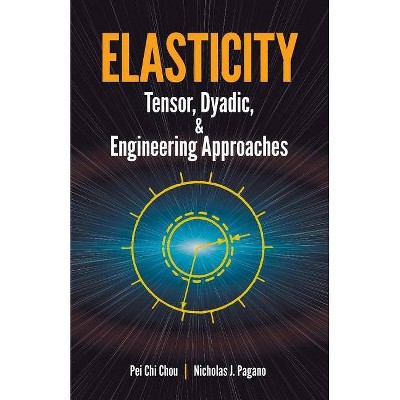Elasticity - (Dover Books on Engineering) by Pei Chi Chou & Chou & M Ed Pagano (Paperback)

Similar Products
Products of same category from the store
AllProduct info
<p/><br></br><p><b> About the Book </b></p></br></br>Exceptionally clear text treats elasticity from engineering and mathematical viewpoints. Comprehensive coverage of stress, strain, equilibrium, compatibility, Hooke's law, plane problems, torsion, energy, stress functions, more. 114 illustrations. 1967 edition.<p/><br></br><p><b> Book Synopsis </b></p></br></br>Written for advanced undergraduates and beginning graduate students, this exceptionally clear text treats both the engineering and mathematical aspects of elasticity. It is especially useful because it offers the theory of linear elasticity from three standpoints: engineering, Cartesian tensor, and vector-dyadic. In this way the student receives a more complete picture and a more thorough understanding of engineering elasticity. Prerequisites are a working knowledge of statics and strength of materials plus calculus and vector analysis. <br>The first part of the book treats the theory of elasticity by the most elementary approach, emphasizing physical significance and using engineering notations. It gives engineering students a clear, basic understanding of linear elasticity. The latter part of the text, after Cartesian tensor and dyadic notations are introduced, gives a more general treatment of elasticity. Most of the equations of the earlier chapters are repeated in Cartesian tensor notation and again in vector-dyadic notation. By having access to this threefold approach in one book, beginning students will benefit from cross-referencing, which makes the learning process easier.<br>Another helpful feature of this text is the charts and tables showing the logical relationships among the equations -- especially useful in elasticity, where the mathematical chain from definition and concept to application is often long. Understanding of the theory is further reinforced by extensive problems at the end of each chapter.<p/><br></br><p><b> From the Back Cover </b></p></br></br>Written for advanced undergraduates and beginning graduate students, this exceptionally clear text treats both the engineering and mathematical aspects of elasticity. It is especially useful because it offers the theory of linear elasticity from three standpoints: engineering, Cartesian tensor, and vector-dyadic. In this way the student receives a more complete picture and a more thorough understanding of engineering elasticity. Prerequisites are a working knowledge of statics and strength of materials plus calculus and vector analysis. The first part of the book treats the theory of elasticity by the most elementary approach, emphasizing physical significance and using engineering notations. It gives engineering students a clear, basic understanding of linear elasticity. The latter part of the text, after Cartesian tensor and dyadic notations are introduced, gives a more general treatment of elasticity. Most of the equations of the earlier chapters are repeated in Cartesian tensor notation and again in vector-dyadic notation. By having access to this threefold approach in one book, beginning students will benefit from cross-referencing, which makes the learning process easier. Another helpful feature of this text is the charts and tables showing the logical relationships among the equations--especially useful in elasticity, where the mathematical chain from definition and concept to application is often long. Understanding of the theory is further reinforced by extensive problems at the end of of each chapter.
Price History
Price Archive shows prices from various stores, lets you see history and find the cheapest. There is no actual sale on the website. For all support, inquiry and suggestion messages communication@pricearchive.us




















